ESP PORSCHE 911 CARRERA 2011 6.G Information Manual
[x] Cancel search | Manufacturer: PORSCHE, Model Year: 2011, Model line: 911 CARRERA, Model: PORSCHE 911 CARRERA 2011 6.GPages: 63, PDF Size: 9.45 MB
Page 2 of 63
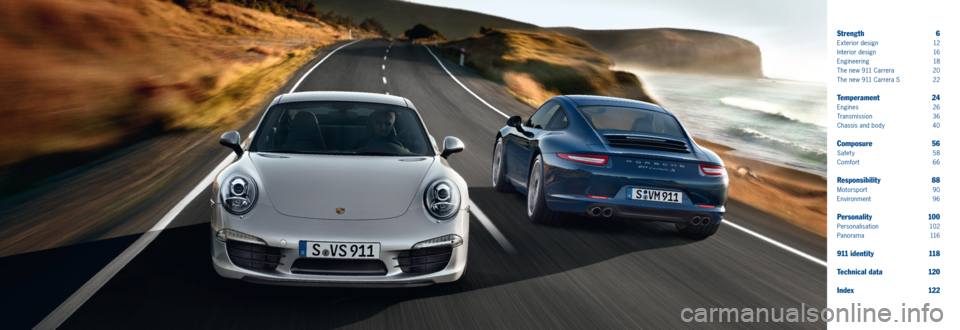
Strength 6
Exterior design 12
Interior design 16
Engineering 18
The new 911 Carrera 20
The new 911 Carrera S 22
Temperament 24
Engines 26
Transmission 36
Chassis and body 40
Composure 56
Safety 58
Comfort 66
Responsibility 88
Motorsport 90
Environment 96
Personality 100
Personalisation 102
Panorama 116
9 11 i d e n t i t y 11 8
Technical data 120
I n d ex 122
Page 4 of 63
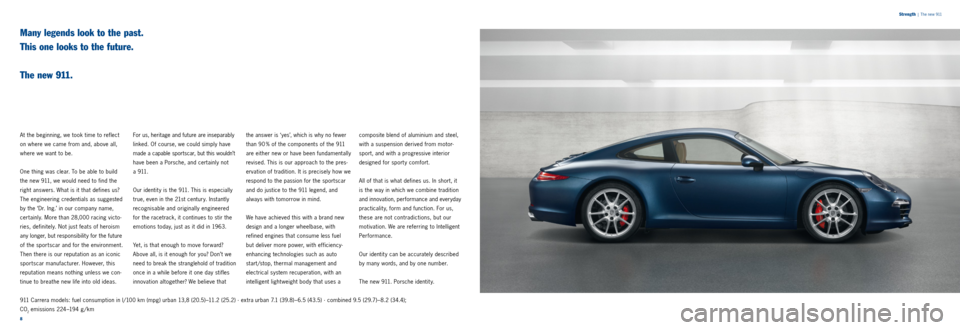
9
8
Many legends look to the past.
This one looks to the future.
The new 911.
At the beginning, we took time to reflect
on where we came from and, above all,
where we want to be.
One thing was clear. To be able to build
the new 911, we would need to find the
right answers. What is it that defines us?
The engineering credentials as suggested
by the ‘Dr. Ing.’ in our company name,
certainly. More than 28,000 racing victo -
ries, definitely. Not just feats of heroism
any longer, but responsibilit y for the future
of the sportscar and for the environment.
Then there is our reputation as an iconic
sportscar manufacturer. However, this
reputation means nothing unless we con -
tinue to breathe new life into old ideas. For us, heritage and future are inseparably
linked. Of course, we could simply have
made a capable sportscar, but this wouldn’t
have been a Porsche, and certainly not
a 9 11 .
Our identit y is the 911. This is especially
true, even in the 21st century. Instantly
recognisable and originally engineered
for the racetrack, it continues to stir the
emotions today, just as it did in 1963.
Yet, is that enough to move forward?
Above all, is it enough for you? Don’t we
need to break the stranglehold of tradition
once in a while before it one day stifles
innovation altogether? We believe that
the answer is ‘yes’, which is why no fewer
than 90 % of the components of the 911
are either new or have been fundamentally
revised. This is our approach to the pres -
ervation of tradition. It is precisely how we
respond to the passion for the sportscar
and do justice to the 911 legend, and
always with tomorrow in mind.
We have achieved this with a brand new
design and a longer wheelbase, with
refined engines that consume less fuel
but deliver more power, with efficiency-
enhancing technologies such as auto
start /stop, thermal management and
electrical system recuperation, with an
intelligent light weight body that uses a composite blend of aluminium and steel,
with a suspension derived from motor
-
sport, and with a progressive interior
designed for sport y comfort.
All of that is what defines us. In short, it
is the way in which we combine tradition
and innovation, performance and everyday
practicality, form and function. For us,
these are not contradictions, but our
motivation. We are referring to Intelligent
Performance.
Our identit y can be accurately described
by many words, and by one number.
The new 911. Porsche identit y.
911 Carrera models: fuel consumption in l/100 km (mpg) urban 13,8 (20.5) –11.2 (25.2) · extra urban 7.1 (39.8) – 6.5 (43.5) · combined 9.5 (29.7) –8.2 (34.4);
CO
2 emissions 224–194 g / km
Strength | The new 911
Page 7 of 63
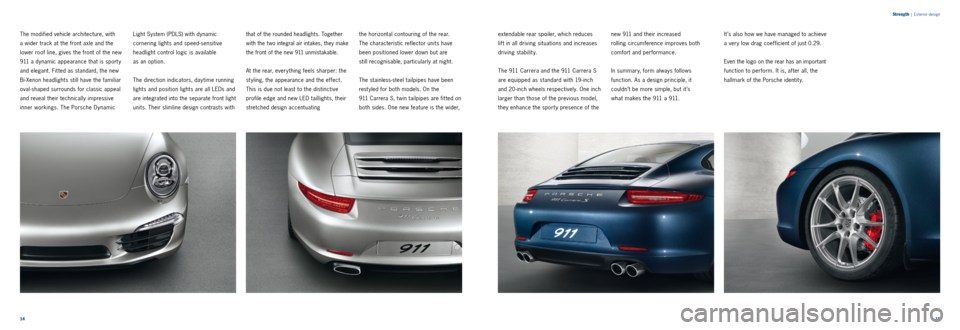
1415
Strength
|
Exterior design
The modified vehicle architecture, with
a wider track at the front axle and the
lower roof line, gives the front of the new
911 a dynamic appearance that is sport y
and elegant. Fit ted as standard, the new
Bi-Xenon headlights still have the familiar
oval-shaped surrounds for classic appeal
and reveal their technically impressive
inner workings. The Porsche Dynamic Light System (PDLS) with dynamic
cornering lights and speed-sensitive
headlight control logic is available
as an option.
The direction indicators, daytime running
lights and position lights are all LEDs and
are integrated into the separate front light
units. Their slimline design contrasts with that of the rounded headlights. Together
with the two integral air intakes, they make
the front of the new 911 unmistakable.
At the rear, every thing feels sharper: the
styling, the appearance and the effect.
This is due not least to the distinctive
profile edge and new LED taillights, their
stretched design accentuating the horizontal contouring of the rear.
The characteristic reflector units have
been positioned lower down but are
still recognisable, particularly at night.
The stainless-steel tailpipes have been
rest yled for both models. On the
911 Carrera S, twin tailpipes are fitted on
both sides. One new feature is the wider, extendable rear spoiler, which reduces
lift in all driving situations and increases
driving stability.
The 911 Carrera and the 911 Carrera S
are equipped as standard with 19-inch
and 20-inch wheels respectively. One inch
larger than those of the previous model,
they enhance the sport y presence of the new 911 and their increased
rolling circumference improves both
comfort and performance.
In summary, form always follows
function. As a design principle, it
couldn’t be more simple, but it ’s
what makes the 911 a 911.
It ’s also how we have managed to achieve
a very low drag coefficient of just 0.29.
Even the logo on the rear has an important
function to perform. It is, after all, the
hallmark of the Porsche identity.
Page 8 of 63
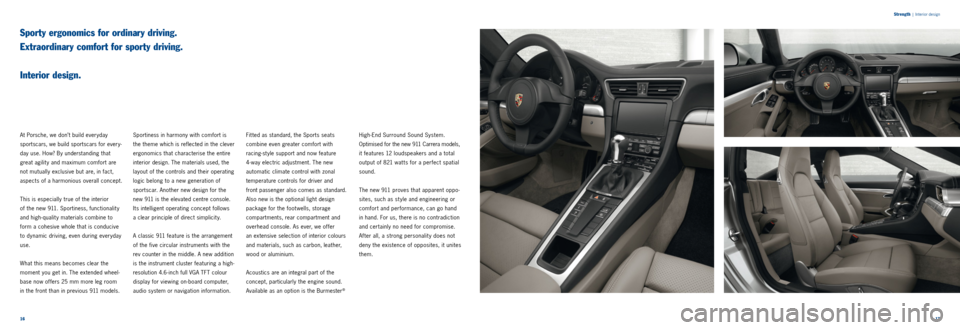
1617
Strength
|
Interior design
Sporty ergonomics for ordinary driving.
Extraordinary comfort for sporty driving.
Interior design.
At Porsche, we don’t build everyday
sportscars, we build sportscars for every -
day use. How? By understanding that
great agilit y and maximum comfort are
not mutually exclusive but are, in fact,
aspects of a harmonious overall concept.
This is especially true of the interior
of the new 911. Sportiness, functionality
and high-quality materials combine to
form a cohesive whole that is conducive
to dynamic driving, even during everyday
use.
What this means becomes clear the
moment you get in. The extended wheel -
base now offers 25 mm more leg room
in the front than in previous 911 models. Sportiness in harmony with comfort is
the theme which is reflected in the clever
ergonomics that characterise the entire
interior design. The materials used, the
layout of the controls and their operating
logic belong to a new generation of
sportscar. Another new design for the
new 911 is the elevated centre console.
Its intelligent operating concept follows
a clear principle of direct simplicity.
A classic 911 feature is the arrangement
of the five circular instruments with the
rev counter in the middle. A new addition
is the instrument cluster featuring a high-
resolution 4.6-inch full VGA TFT colour
display for viewing on-board computer,
audio system or navigation information. Fit ted as standard, the Sports seats
combine even greater comfort with
racing-st yle support and now feature
4 -way electric adjustment. The new
automatic climate control with zonal
temperature controls for driver and
front passenger also comes as standard.
Also new is the optional light design
package for the foot wells, storage
compartments, rear compartment and
overhead console. As ever, we offer
an extensive selection of interior colours
and materials, such as carbon, leather,
wood or aluminium.
Acoustics are an integral part of the
concept, particularly the engine sound.
Available as an option is the Burmester
® High-End Surround Sound System.
Optimised for the new 911 Carrera models,
it features 12 loudspeakers and a total
output of 821 wat ts for a perfect spatial
sound.
The new 911 proves that apparent oppo -
sites, such as st yle and engineering or
comfort and performance, can go hand
in hand. For us, there is no contradiction
and certainly no need for compromise.
After all, a strong personalit y does not
deny the existence of opposites, it unites
them.
Page 10 of 63
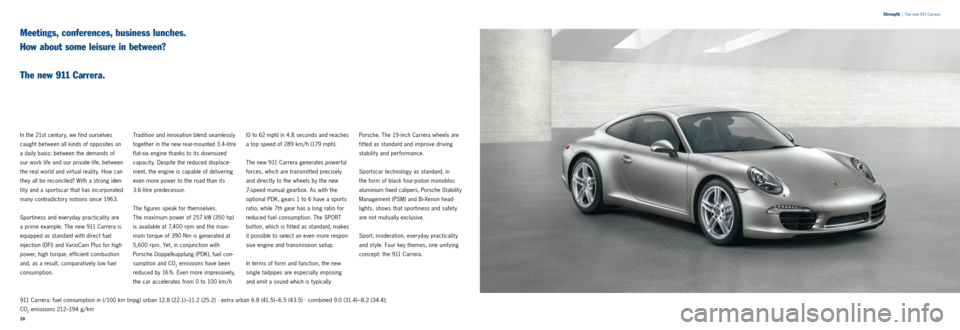
2021
Strength
| The new 911 Carrera
Meetings, conferences, business lunches.
How about some leisure in between?
The new 911 Carrera.
In the 21st century, we find ourselves
caught bet ween all kinds of opposites on
a daily basis: bet ween the demands of
our work life and our private life, between
the real world and virtual realit y. How can
they all be reconciled? With a strong iden -
tit y and a sportscar that has incorporated
many contradictory notions since 1963.
Sportiness and everyday practicality are
a prime example. The new 911 Carrera is
equipped as standard with direct fuel
injection (DFI) and VarioCam Plus for high
power, high torque, ef ficient combustion
and, as a result, comparatively low fuel
consumption. Tradition and innovation blend seamlessly
together in the new rear-mounted 3.4-litre
flat-six engine thanks to its downsized
capacity. Despite the reduced displace
-
ment, the engine is capable of delivering
even more power to the road than its
3.6-litre predecessor.
The figures speak for themselves.
The maximum power of 257 kW (350 hp)
is available at 7,400 rpm and the maxi -
mum torque of 390 Nm is generated at
5,600 rpm. Yet, in conjunction with
Porsche Doppelkupplung (PDK), fuel con -
sumption and CO
2 emissions have been
reduced by 16 %. Even more im pres
sively,
the car accelerates from 0 to 100 km/ h
(0 to 62 mph) in 4.8 seconds and reaches
a top speed of 289 km/ h (179 mph).
The new 911 Carrera generates powerful
forces, which are transmit ted precisely
and directly to the wheels by the new
7-speed manual gearbox. As with the
optional PDK, gears 1 to 6 have a sports
ratio, while 7th gear has a long ratio for
reduced fuel consumption. The SPORT
but ton, which is fit ted as standard, makes
it possible to select an even more respon -
sive engine and transmission setup.
In terms of form and function, the new
single tailpipes are especially imposing
and emit a sound which is t ypically Porsche. The 19-inch Carrera wheels are
fit ted as standard and improve driving
stability and performance.
Sportscar technology as standard, in
the form of black four-piston monobloc
aluminium fixed calipers, Porsche Stability
Management (PSM) and Bi-Xenon head -
lights, shows that sportiness and safety
are not mutually exclusive.
Sport, moderation, everyday practicality
and st yle. Four key themes, one unifying
concept: the 911 Carrera.
911 Carrera: fuel consumption in l/100 km (mpg) urban 12.8 (22.1) –11.2 (25.2) · extra urban 6.8 (41.5) – 6.5 (43.5) · combined 9.0 (31.4) –8.2 (34.4);
CO
2 emissions 212–194 g / km
Page 13 of 63

2627
Temperament
|
Engines
To give more and take less.
That’s Porsche engineering.
Engines.
You could ask whether the sportscar is
still relevant. It would be a good question,
but you might as well ask the same of
dreams.
The answer to both questions lies in
the future or, to be more precise, in the
future of the sportscar. In the new 911,
the future has already begun. The highly
ef ficient, state - of-the -art engines make
a considerable contribution to reducing
fuel consumption, but their sound is still
unmistakably Porsche. The new 911 engines are also unmistaka
-
bly sport y thanks to the new SPORT
but ton fit ted as standard. At the push
of a button, the engine becomes tuned
for a sharper response and engine
dynamics that are even more direct.
The 3.4-litre engine of the new
911 Carrera demonstrates, therefore,
that performance and efficiency need
not be mutually exclusive. Rather, the
downsized engine capacity and increased
maximum torque are the intelligent basis
by which power output can be increased
in an environmentally acceptable and
sustainable way. Fuel consumption and CO2 emissions have been reduced
by up to 16 % compared with the previous
model.
In their search for improved efficiency,
our engineers analysed an extensive
series of engine components. Answers
were found, including rapid heating
of the engine and gearbox by the new
thermal management after an engine
start, optimised air induction and the
extremely effective direct fuel injection
(DFI).
The same principle applies to the 3.8-litre
engine in the 911 Carrera S. There has been no change in displacement since
the previous model, but power output has
been increased while fuel consumption
has been reduced by up to 14 %.
Weight is critical to efficiency. This is
why the engines have a light-alloy
construction, which makes them light -
weight and structurally rigid for improved
fuel economy and a long life.
The engine is the intelligent core of our
identit y. What else could the ‘Dr. Ing.’ in
our company name possibly stand for?
911 Carrera models: fuel consumption in l/100 km (mpg) urban 13,8 (20.5) –11.2 (25.2) · extra urban 7.1 (39.8) – 6.5 (43.5) · combined 9.5 (29.7) –8.2 (34.4);
CO
2 emissions 224–194 g / km
Page 19 of 63

462135
7R
3839
Porsche Doppelkupplung (PDK).
Available as an option for the new 911
models is 7-speed PDK, featuring manual
and automatic modes. This double - clutch
transmission has been further refined and
enables extremely fast gear changes with
no interruption in the flow of power, which vastly improves acceleration at the
same time as reducing fuel consumption.
In total, PDK has seven gears at its disposal.
Gears 1 to 6 have a sports ratio and top
speed is reached in 6th gear. 7th gear has
a long ratio and helps to reduce fuel
consumption by keeping engine revs low.
Porsche Doppelkupplung (PDK)
PDK is essentially t wo gearboxes in one
and thus requires t wo clutches. This
double-clutch arrangement provides an
alternating, non-positive connection
bet ween the t wo half gearboxes and the
engine by means of t wo separate input
shafts.The flow of power from the engine is
transmit ted through one half gearbox and
one clutch at a time, while the next gear
is preselected in the second half gearbox.
During a gear change, therefore, one
clutch simply opens and the other closes
at the same time, enabling gear changes
to take place within milliseconds.
Temperament | Transmission
The effect is instant. Driving feels even
sportier and more dynamic, and agility
is increased. Depending on the gearshift
programme (SPORT button activated
or deactivated), the gear change is opti -
mised for comfort or for sport y driving.With the optional Sport Chrono Package,
PDK is enhanced by the ‘Launch Control’
and ‘motorsport- derived gearshif t strategy’
functions (p. 50). In this way, optimum use is made of the
vehicle’s momentum, allowing it to coast
for longer distances.
For example, you may want to slow down
from 100 km/ h (62 mph) to 80 km/ h
(49 mph) in anticipation of the change of
speed limit ahead. As soon as you release
the accelerator pedal, PDK deselects
the current gear automatically and you
begin to coast in neutral until you have
reached your desired speed. The moment
you engage the accelerator or brake
pedal, PDK selects the appropriate gear
smoothly and seamlessly within a fraction
of a second.
Another way to reduce fuel consumption is
to utilise the coasting function on downhill
gradients that are gentle enough for you
to maintain a constant speed. Efficient on
long journeys, such as on the motorway,
PDK remains ready to respond as swiftly
and precisely as you would expect.
In short, driving in coasting mode makes
a real impact on fuel consumption without
any need for compromise on comfort or
sporty performance.
Coasting.
The ‘coasting’ function available with
Porsche Doppelkupplung (PDK) enables
you to save even more fuel where the
situation allows. The engine is decoupled
from the transmission to prevent
deceleration caused by engine braking.
Page 21 of 63
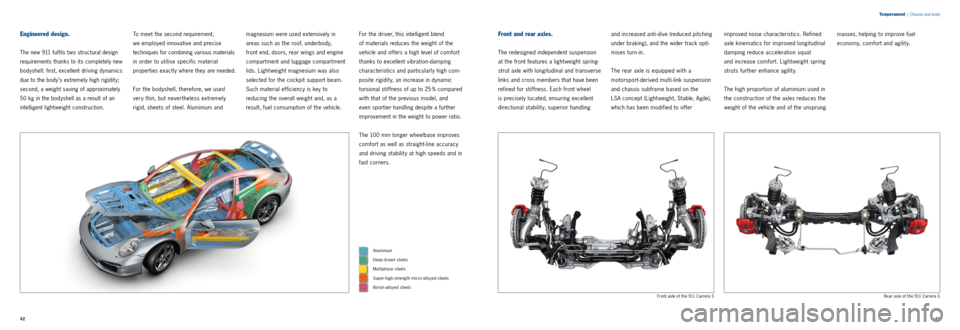
4243
Temperament
| Chassis and body
Engineered design.
The new 911 fulfils two structural design
requirements thanks to its completely new
bodyshell: first, excellent driving dynamics
due to the body’s extremely high rigidit y;
second, a weight saving of approximately
50 kg in the bodyshell as a result of an
intelligent lightweight construction.
To meet the second requirement,
we employed innovative and precise
techniques for combining various materials
in order to utilise specific material
properties exactly where they are needed.
For the bodyshell, therefore, we used
very thin, but nevertheless extremely
rigid, sheets of steel. Aluminium and magnesium were used extensively in
areas such as the roof, underbody,
front end, doors, rear wings and engine
compartment and luggage compartment
lids. Light weight magnesium was also
selected for the cockpit support beam.
Such material efficiency is key to
reducing the overall weight and, as a
result, fuel consumption of the vehicle. For the driver, this intelligent blend
of materials reduces the weight of the
vehicle and offers a high level of comfort
thanks to excellent vibration-damping
characteristics and particularly high com -
posite rigidit y, an increase in dynamic torsional stiffness of up to 25 % compared
with that of the previous model, and
even
sportier handling despite a further
improvement in the weight to power ratio.
The 100 mm longer wheelbase improves
comfort as well as straight-line accuracy
and driving stabilit y at high speeds and in
fast corners.
Front and rear axles.
The redesigned independent suspension
at the front features a light weight spring-
strut axle with longitudinal and transverse
links and cross members that have been
refined for stiffness. Each front wheel
is precisely located, ensuring excellent
directional stability, superior handling and increased anti-dive (reduced pitching
under braking), and the wider track opti
-
mises turn-in.
The rear axle is equipped with a
motorsport-derived multi-link suspension
and chassis subframe based on the
LSA concept (Lightweight, Stable, Agile),
which has been modified to offer improved noise characteristics. Refined
axle kinematics for improved longitudinal
damping reduce acceleration squat
and increase comfort. Light weight spring
struts further enhance agilit y.
The high proportion of aluminium used in
the construction of the axles reduces the
weight of the vehicle and of the unsprung masses, helping to improve fuel
economy, comfort and agility.
Rear axle of the 911 Carrera S
Front axle of the 911 Carrera S
Aluminium
Deep-drawn steels
Multiphase steels
Super-high-strength micro-alloyed steels
Boron-alloyed steels
Page 24 of 63

4849
Temperament
| Chassis and body
Power steering.
Another possible definition of efficiency
is a system that works only when it is
needed, and then does so in a particularly
effective way.
This was the guiding principle for our
engineers in the development of the new electromechanical power steering.
Statistics show that a car drives in a
straight line 90
% of the time. Unlike
conventional hydraulic pumps, the electric
motor uses energy only when the steering
wheel is actually turned. The absence
of hydraulic fluid also makes the system
more beneficial to the environment.
As far as the other 10 % is concerned, we’re
optimally prepared as the steering system
is t ypically Porsche. It features a variable
steering ratio and responds sensitively
and directly at the same time as providing
customary agility, a high level of comfort
and precisely selected feedback from the
road. Our definition of efficient.Power steering Plus.
Power steering Plus, the speed -sensitive
power-steering system, is available
as an option for the 911 Carrera models.
At high speeds, the steering is as firm
as you would expect and responds with
extreme precision while steering comfort
remains as high. At low speeds, the
steering ratio of Power steering Plus
adjusts for much easier manoeuvring
and parking.
SPORT button.
Fit ted as standard, the new SPORT
but ton enables you to select a suspension
setup where the emphasis is on either
comfort or sport y performance. At the
push of a button, the electronic engine
management system switches the engine
mapping to offer an even sharper
response and engine dynamics that are
more direct.
In vehicles with Porsche Doppelkupplung
(PDK), upshifts take place at higher
engine speeds and downshifts happen sooner. In addition, coasting mode and
the auto start/stop function are automati
-
cally deactivated. If fitted, the optional
sports exhaust system is also activated
automatically.
Sport Chrono Package.
The Sport Chrono Package including
dynamic engine mounts is available
as an option. This integrated system
provides simultaneous enhancement for
the chassis, engine and transmission.
Every day can be sports day.
Additional performance enhancement systems.
Page 25 of 63

5051
Temperament
| Chassis and body
Included in the package are a performance
display, a digital and an analogue stop -
watch and the SPORT PLUS but ton. An
additional display in the steering wheel
and instrument cluster indicates whether
the SPORT but tons and Launch Control
have been activated.
On activation of SPORT PLUS mode,
Porsche Active Suspension Management
(PASM) and, in the S model, optional
Porsche Dynamic Chassis Control (PDCC)
switch to a harder damping set ting
and offer more direct steering and,
therefore, better road holding.
In SPORT PLUS mode, the trigger thresh -
old for PSM is raised. Agilit y is perceptibly
enhanced when braking for corners with
PSM, allowing sportier braking and exit
acceleration. For maximum dexterit y,
PSM can be set to standby while the car
is still in SPORT PLUS mode. For safet y,
it is set to intervene automatically only
when ABS assistance is required on both
the front wheels.
In combination with PDK, the Sport
Chrono Package has t wo additional functions for a sport y drive that borders
on a motorsport experience. The first
is ‘Launch Control’, which can be used
on the track to achieve the best possible
standing start – a racing start.
The second function is the ‘motorsport-
derived gearshif t strategy’. Using this,
Porsche Doppelkupplung (PDK) is geared
up for extremely short shift times and optimum shift points for the maximum
acceleration available. This combination
of uncompromising and involving perfor
-
mance is ideal for the racetrack.
A key component of the Sport Chrono
Package is the stopwatch mounted on
the dashboard. In conjunction with the
optional PCM, a special performance
display enables you to view store and evaluate lap times or other driving
times. It shows the total driving time,
lap distance, lap number and lap times
re c o rde d s o f a r.
A feature of the Sport Chrono Package
borrowed from motorsport is the dynamic
engine mounts. These exploit the laws
of physics for your own driving pleasure.
Dynamic engine mounts.
You don’t have to take the new 911 onto
the racetrack. But you can, more so
than ever, because dynamic engine
mounts are now included as part of the
Sport Chrono Package. Based on the
engine mounts of the 911 GT3 and
911 Turbo models, it is the first time that they have been available for the
911 Carrera. Even if track racing is
not for you, dynamic engine mounts
make a decisive contribution to dynamic
performance on the road, too.
The electronically controlled system mini -
mises the oscillations and vibrations of the
entire drive train, especially the engine.
The engine is bolted to the body by t wo
mounts. Like any mass, it obeys the law
of inertia. This means that it will continue
moving in a uniformly straight line unless
some force causes it to change direction.
Put more simply: when you are driving
into a bend, the vehicle will follow your
steering but, at first, the mass of the
engine will not. This means that the rear
of the vehicle will ultimately be pushed
out wards as a result of the engine’s
force of inertia.
Dynamic engine mounts minimise
this effect. Steering angle and both
longitudinal and lateral acceleration
are constantly recorded by sensors. The stiffness and damping performance
of the engine mounts adapt to changes
in driving st yle and road surface condi
-
tions, which is achieved by use of a fluid
magnetised in an electrically generated
field. This results in greater traction
and perceptibly more stable handling
under load change conditions and in
fast corners.